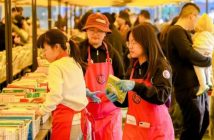
For Beijingers, visiting a temple fair for Spring Festival is as traditional as making dumplings. Originally the site of sacrifices to village gods, the city’s temple fairs date from the Tang Dynasty (618-907 AD). During the Liao Dynasty (916-1125 AD), the events also came to symbolize the arrival of spring. Over time, merchants and peddlers started selling their wares to the devotees who burned incense and paid tribute to the gods.
There are annual temple fairs both large and small in Beijing. During Spring Festival, revelers can expect cultural performances, vendors, scrumptious snacks, and traditional handicrafts. Folk performances include lion dances, cross talk (a form of Chinese comedy), kung fu demonstrations, puppet shows, and yangge (a type of harvest dance). You can also find clay figurines and paper cuts to decorate your home with.
This year, Spring Festival begins on January 31 and marks the Year of the Horse. There will be temple fairs scattered all over the city. To help you narrow down your options, we profile some of the more prominent ones.
The Busiest: Ditan Park Temple Fair 地坛庙会
The site of the oldest and most bustling temple fair in the capital, Ditan Park is a must-see for first-time attendees. Located by North Second Ring Road, this is where the imperial families of the Ming (1368-1644) and Qing (1644-1911) dynasties offered sacrifices to the god of the earth. A re-enactment of this ceremonial ritual is widely considered to be the highlight of the fair.
Walking through a sea of people and red lanterns in the park, you will come across folk performances, ancient costume displays, art exhibitions, snow sculptures, and venders selling traditional handicrafts. There are also snack stalls featuring specialties from Beijing, Sichuan, Tianjin, and Xinjiang, with vendors yelling in different dialects. However, note that this is not the best food you will ever have and prices are relatively high. Last year, a lamb kebab from the Xinjiang stall cost RMB 20. That being said, the temple fair’s lively ambiance is hard to beat.
RMB 2. Jan 30 to Feb 6 8am-5pm. Ditan Park, A2, Andingmenwai Dajie, Dongcheng District (6421 4657) 东城区安定门外大街2号地坛公园
The Most Regal: Yuanmingyuan Royal Temple Fair 圆明园皇家庙会
Once known as “the Versailles of the East,” Yuanmingyuan (the Old Summer Palace) was a bustling Spring Festival venue for the royal family during the Qing Dynasty (1644-1911). Despite the site’s checkered past (it was pillaged and burned down by French and British forces during the Second Opium War), the administration office of Yuanmingyuan decided in 2010 to establish a temple fair. Although there has been debate on whether such a site should remain quiet as a reminder of its ill-fated history, the annual event remains popular among locals.
The fair has activities like ice skating performances, a palace-themed culture exhibition, and a royal market, which offers imperial-style snacks, calligraphy, paintings, crafts, and more. Attendees can learn about the cuisine and costumes of the Qing Dynasty. Locals can also be spotted attempting to solve lantern riddles and practicing calligraphy.
RMB 10. Jan 31-Feb 6 7am-7:30pm. Yuanmingyuan, 28 Qinghua Xilu, Haidian
District (6261 7801) 海淀区清华西路28号圆明园
The Most Eclectic: Shijingshan Temple Fair 石景山庙会
Located at the crossroads of Xi Chang’an Jie and West Fifth Ring Road, the European-style Shijingshan Amusement park promotes itself as “the Disneyland of Beijing.” During the winter the park stays relatively quiet until Spring Festival, when it puts on a temple fair that seems more like a carnival parade than a traditional cultural event at times.
Besides traditional performances like lion dances and stilt-walking, the temple fair is known for its various exotic performances, ranging from Japanese fan dances to a Korean drum dances, Latin dancing, and Russian dances. This year, organizers are planning to have 41 Chinese food stalls, ten Western food stalls, and up to 20 stalls selling folk art, music, and snacks. The amusement park will continue to operate rides during the temple fair.
RMB 10. Jan 31-Feb 6, 9am-5pm. Shijingshan Amusement Park, 25 Shijingshan lu, Shijingshan District(6887 4060) 石景山区石景山路25号石景山游乐园
The Most Literary: Daguanyuan Temple Fair 大观园庙会
Daguanyuan is based on an aristocratic garden described in the masterpiece A Dream of Red Mansions by Qing Dynasty author Cao Xueqin (1715-1763). The garden was built in 1983 to serve as a backdrop for the CCTV television series of the same name; it was opened to the public in 1989.
At Daguanyuan’s temple fair, visitors can get a sense of the grandness of the Red Mansions and the luxurious lifestyle of an upper-class Chinese family. Refined dishes from the novel will be available to try and actors will re-enact some of the novel’s classic passages. However, you do not have to be a Chinese literature buff to enjoy the event. Kids will find yummy snacks, jigsaw puzzles, magician sets, and toys for sale.
RMB 40. Jan 31-Feb 4, 9am-5pm. Daguanyuan Temple, 12 Nancaiyuan Xijie, Xicheng District (6354 4993) 西城区南菜园西街12号大观园
The Most Authentic: Dongyue Temple Fair 东岳庙庙
Despite the name “temple fairs,” this is one of the only annual celebrations located in an actual temple. Founded during the Yuan Dynasty (1271-1368), Dongyue is a small Taoist temple was dedicated to the god of Mount Tai, one of China’s five Taoist sacred mountains. Despite its small size, Dongyue’s temple fair is considered the most traditional and is a favorite among locals. Many visitors attend especially to pray and burn incense.
Entertainment usually includes kung fu shows, shadow puppetry, and Taoist music performances and exhibitions. Local calligraphers will be on hand to demonstrate the art of duilian, a couplet written on vertical strips of red paper especially for Spring Festival and given to visitors for free.
RMB 10. Jan 31-Feb 6, 8am-4.30pm. Dongyue Temple, 141 Chaoyangmen Waidajie, Chaoyang District (6551 0151) 朝阳区朝阳门外大街141号东岳庙
Photo from Flickr user LMOON.TONG
This article originally appeared on p28-31 of the beijingkids January 2014 issue.
Check out the PDF version online at Issuu.com



